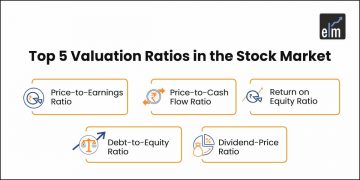As informed investors, we may often look towards the tools of fundamental analysis to assess our investments.
One such tool is the intrinsic value.
In simple terms, the intrinsic value refers to the self-generated value of any investment avenue.
It helps us to understand if the investment is able to generate returns well, without the help of any external factors.
| Table of Contents |
|---|
| Why should we calculate Intrinsic Value? |
| When should we calculate Intrinsic Value? |
| Calculation of Intrinsic Value |
| Discounted Cash Flow Model |
| The Multiples Approach |
In this article, we will discuss the features and the various methods of intrinsic value calculation for investors.
Why should we calculate Intrinsic Value?
Many times, as investors, we might feel that some market factors may have led to a stock being overpriced or underpriced.
To check if our instincts are correct, we can use the formulas of intrinsic value to determine the fundamental value of the stock.
Intrinsic value is an important aspect for value investors, who look for stocks which might be undervalued in the market.
When should we calculate Intrinsic Value?
Investors and companies usually do intrinsic value calculation when –
- An investment is to be made in a company;
- A company is going through a merger, an acquisition or restructuring; or
- A business’s ownership is being sold off.
Intrinsic Value Calculation
There are two main models of intrinsic value calculation for investments.
Suggested Read : How to calculate intrinsic value
Each of these models depend on certain assumptions, and one should assess the information available about the company, before choosing a relevant model.
Following are the models for intrinsic value calculation, with their pros and cons –
I. Discounted Cash Flow Model
In this model, an investment is valued by forecasting its cash flows for some years, and discounting them to calculate a present value.
This model is based on the premise that an investment’s value is created through the cash it can generate, rather than just its supply and demand.
Learn to evaluate company with Company Valuation Course by Market Experts
Investors and companies can use this model to evaluate and compare the intrinsic value to its market value, or to the intrinsic value of other potential investments.
For example, for intrinsic value calculation, the DCF of a share, you can discount the values of all its cash inflows (Dividends and sale value).
On the other hand, companies can use this formula to evaluate the effects of any changes they might be looking to make to their working.
For example, if a business is planning to purchase new machinery, it can use this model to compare how much sales it can generate in comparison to the old machinery.
The formula is given by –
DCF = First cash flow/(1+r)^1 + Second cash flow/(1+r)^2…+ nth cash flow/(1+r)^n
Here, DCF = discounted cash flow;
n = number of years; and
r = discounting rate.
If you have to choose between two investments, the one with the higher DCF is a better investment.
Pros:
- This formula accounts for the time value of money, with the usage of a relevant discount rate.
- The formula boils down the answer to a single, comparable value. You can compare this value to other potential investments, or the initial investment to make your investment.
Cons:
- This method relies on a lot of assumptions. If these assumptions are wrongly made, the answer and comparison will be flawed as well.
- Since the calculation relies on assumptions, it has no relations to the real world. To make better comparisons, you can use other valuation methods with it.
II. The Multiples Approach
This intrinsic value calculation approach focuses on using different indicators of performance to compare the similar types of investments.
It works on the premise that “similar assets sell at similar prices”.
This means that, being in the same category of investments, their performance will only differ due to their ability to generate cash, which is their intrinsic value.
While there are many ratios available to use, two common ones include the following –
1. P/E Ratio
This is a ratio of a company’s current share price to the earnings-per-share.
It is given by –
P/E Ratio = Market value per share/earnings per share
If the P/E ratio is high, it indicates overvaluation, and vice-versa.
Again, this differs for different sectors. This means that an FMCG sector might have a higher P/E than an I.T Sector.
Thus, if a company’s P/E is less in comparison to its sector than its expected to be undervalued and vice a versa.
2. PEG Ratio
As an upgrade to the P/E ratio, this ratio factors in expected growth of the EPS to make the indicator more relevant.
It is given by –
PEG ratio = (market price/EPS)/EPS Growth
While comparing two companies, the one with the higher PEG ratio has a more justifiable P/E ratio, and therefore, it can be considered better.
Again an EPS growth has to be calculated using CAGR model for estimated growth.
Pros:
- Unlike the DCF model, this method uses lesser assumptions, thus making it easier to use.
- By using the present indicators of the different companies, it is more connected to the real-life situation of these companies than the DCF model.
Cons:
- This entire method depends on the variables you choose. It doesn’t give a single value, but gives different perspectives as per the different variables.
- By comparing the investments of the same type, we are automatically assuming the non-existence of any company-specific factors which could have affected the indicators. This can lead to a flawed investment decision.
The models discussed above are not the only ones to use, but they are the most commonly known and used. They can be used for varying types of investments by both investors and companies.
What’s more, we can use these models in combination with other techniques to make the most accurate decision as well.
Intrinsic value is an essential element that can help us choose investments on the basis of the cash it generates.
By staying mindful of the various assumptions to undertake with each method, we can easily use the intrinsic value to take a suitable investment decision.
Key Takeaways:
- Intrinsic value calculation highlights the ability of an investment to generate cash.
- Both investors and companies can use it to compare and make suitable investments.
- DCF and the multiples methods are two popular ways to assess this particular value of an investment.
Happy Learning!






